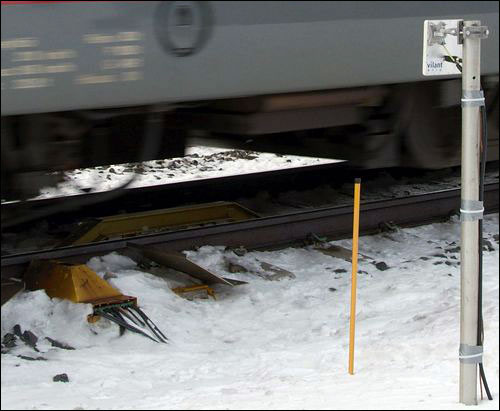Following the conclusion of a one-year pilot, Liikennevirasto, the Finnish Transport Agency, is installing a radio frequency identification solution designed to improve the safety and efficiency of trains throughout Finland. The agency is employing a solution provided by Vilant to connect the unique ID number assigned to each rail car with information related to that car’s axles and wheels, as well as the electrical contacts on a pantograph (the extendable arm that a train utilizes to connect with overhead power lines)
The system capitalizes on an installation of Vilant’s RFID technology undertaken by train operator VR Transpoint, which is using the Vilant system with Confidex Ironside passive ultrahigh-frequency (UHF) EPC Gen 2 RFID tags attached to VR Transpoint’s fleet of railcars to track work processes within its rail yard (see Finnish Railroad Streamlines Operations).

Liikennevirasto manages and maintains the rails, as well as traffic on Finland’s entire network. This includes ensuring that the railcars are in proper working condition. The firm spends approximately €135 million ($166 million) each year to maintain 5,919 kilometers (3,678 miles) of track, as well as ensure that each car’s wheel axles are not overheating, and that the speeds fall within approved limits. For example, passenger trains should not exceed 220 kilometers per hour (137 miles per hour), while freight trains may only travel at up to 120 kilometers per hour (75 miles per hour).
The agency conducts inspections of railcars, and may require the replacement of parts that it expects to fail. To aid in this effort, Liikennevirasto installed a temperature-detection system that can measure the axle temperature of every passing railcar. Hot axle-box detectors (HABD), installed under the tracks, are designed to sense any overheated (and, thus, faulty) axle bearings of cars passing overhead.
At some locations, the agency also uses pantograph detectors to spot wear or damage to the contact strip of an electric locomotive’s pantograph, and wheel impact load detectors to determine irregularities in a wheel that could damage the tracks and decrease ride quality. This information can also be linked to the unique ID number of a car’s RFID tag. Currently, however, the system can determine only that an axle bearing, pantograph contact or wheel is in need of repair—it cannot identify which car on that train is experiencing the problem.
Liikennevirasto began testing the RFID technology in 2009, and then conducted a trial of four fixed readers on its rails during 2011 and 2012. For the pilot, Liikennevirasto and Vilant installed four Vilant Railroad Reader Units at multiple locations along the rail lines, near the cities of Oulu and Mäntsälä. The interrogators were mounted on poles located approximately 2.5 meters (8.2 feet) from the railroad track itself, so they could capture the unique ID encoded to each Ironside tag attached to the sides of passing train cars.
In Vilant’s Train Analyzer software, residing on the firm’s back-end hosted server, each tag’s unique ID number was linked to the car’s serial number, as well as to the operator in ownership and other details. In addition to linking the ID to temperature data—based on the read time at the previous reader unit—the Vilant Train Analyzer software could determine how fast the train was moving. In that way, the agency could address any problems involving the trains’ speed, by contacting the operator, as well as identifying any problems with the train axles.
According to Liikennevirasto, the permanent solution currently being deployed will consist of 120 RFID reader units, installed along tracks throughout Finland. Currently, there are approximately 11,000 rail cars in use within the country, most with Ironside tags attached to them. Thanks to the RFID technology, Vilant reports, the system will now be able to identify which railcar axle is overheating, enabling the agency’s staff to remove that car from the active fleet for repair of any faulty part before it fails. “It allows for pre-emptive maintenance,” says Vesa-Pekka Tapper, Vilant’s business development director. “For example, you might tell already, beforehand, that it is likely that an axle bearing will fail in the near future, based on the recorded temperature values.”
The completed system is slated to be taken live in about 18 months, at which time Liikennevirasto expects that any train cars lacking RFID tags will have tags attached to them. The key benefits that the agency hopes to gain from the system, according to Arlinda Sipilä, Vilant’s director of products and marketing, are not just fault detection linked to a specific railcar, but also real-time monitoring of rolling stock—in other words, knowing where all cars are located at any given time—in order to improve traffic and detect any problems.
What’s more, the agency plans to share its RFID-based data with the operator companies that own the trains, thereby informing them of the exact locations of their own trains, their arrival times at specific stations, the speed at which their trains are being operated and other traffic-related conditions.

